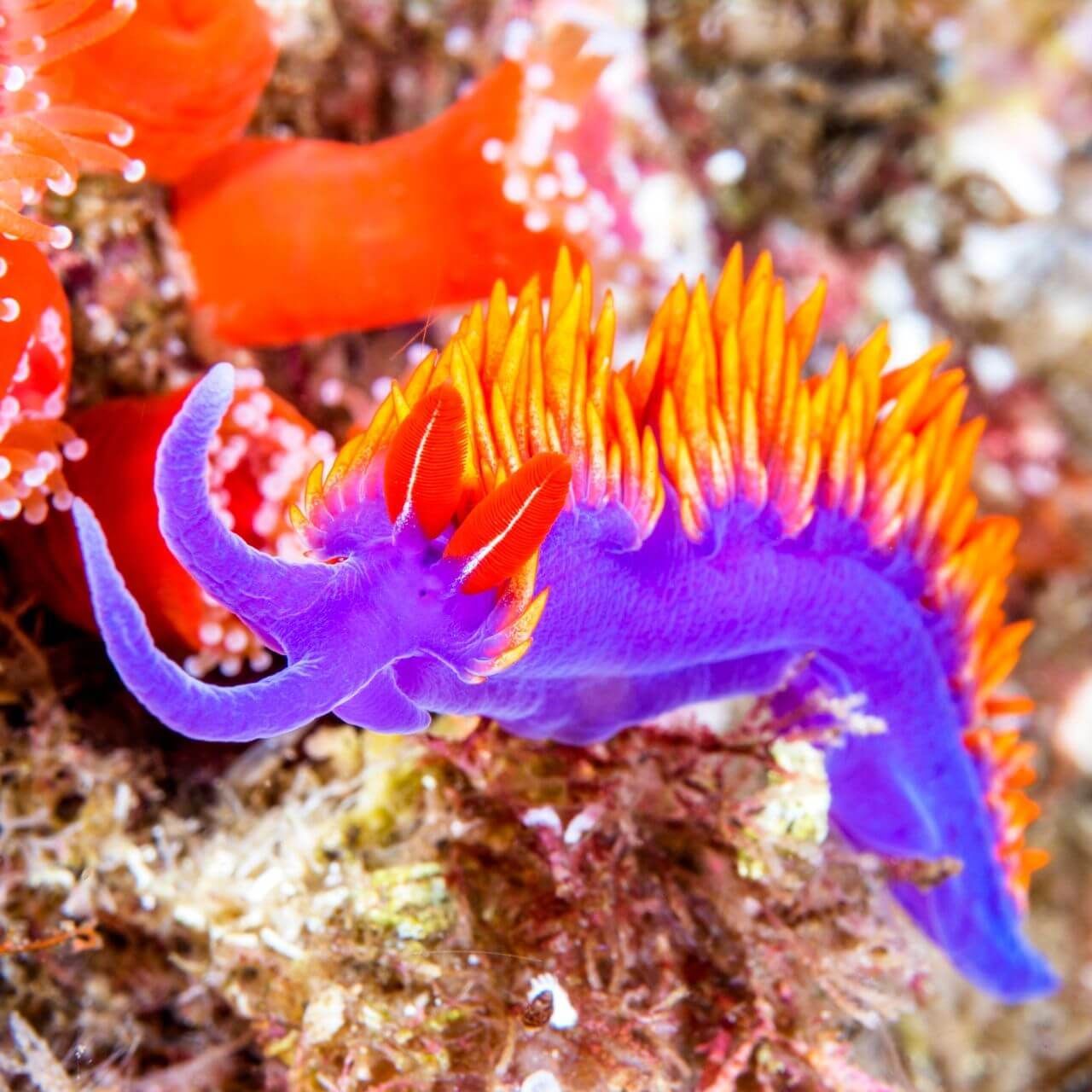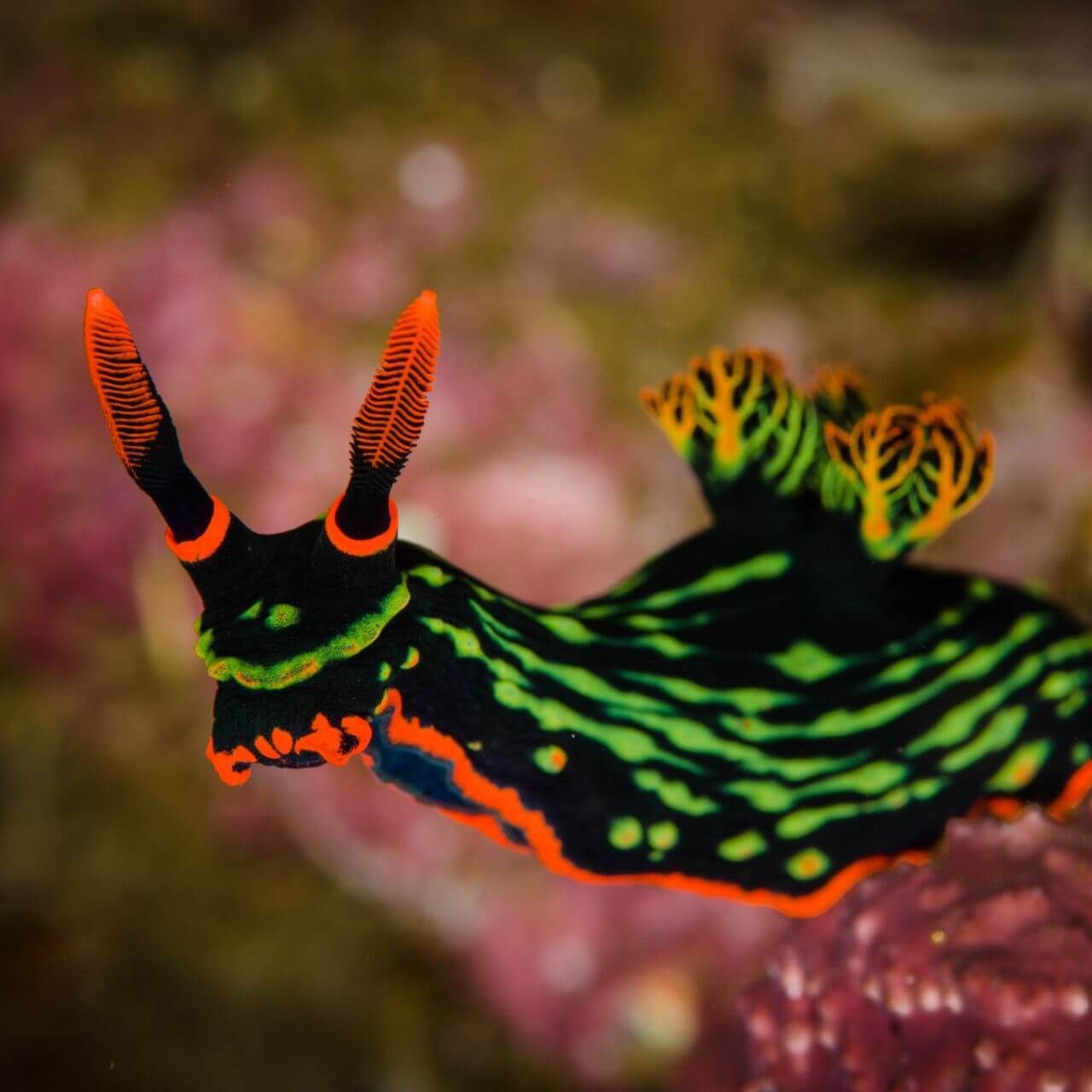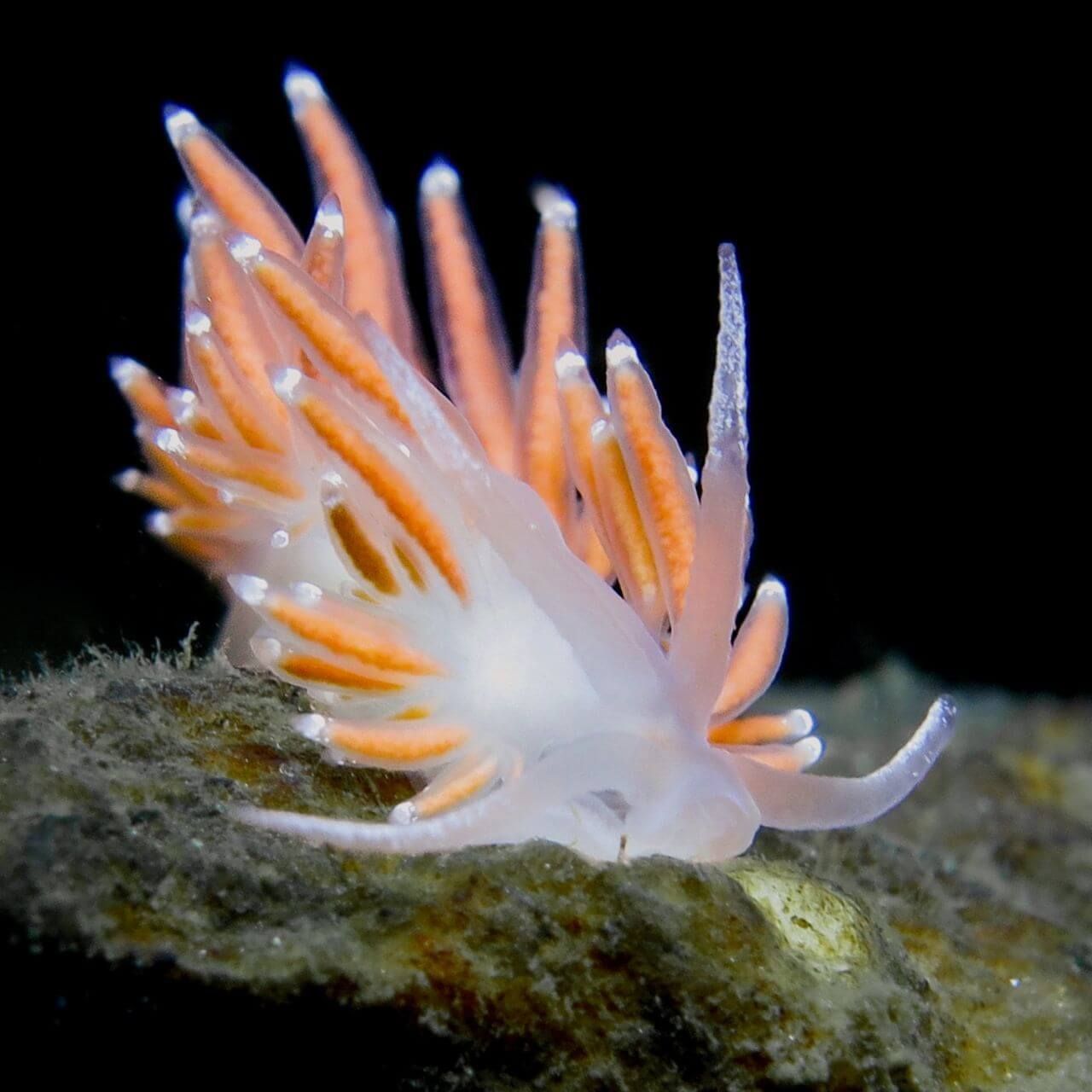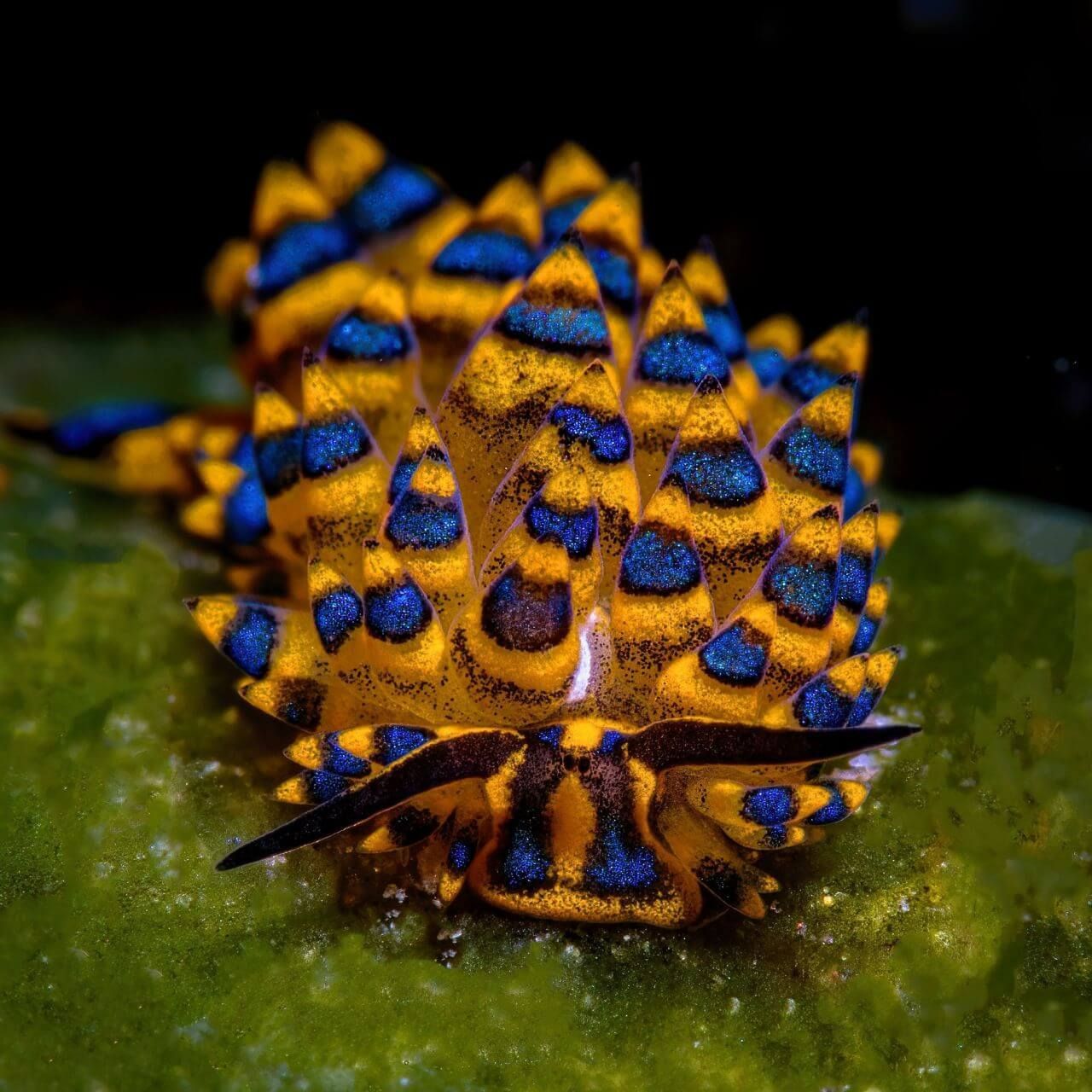Nudibranchs

Let's Learn About Nudibranchs
Word of the Week
Benthic
Benthic organisms live at the bottom of a body of water (like a lake or ocean). For example, nudibranchs, crabs, and corals are benthic animals!
Many benthic animals are not able to swim. Some are even stuck in the same spot for their whole lives. Most nudibranchs move around by crawling across the ocean floor.
Fast Facts

Where do nudibranchs live?
Nudibranchs live in many ocean habitats across most of the world.
Some nudibranch species are found in the warm, shallow water of the tropics. Other are found in freezing waters near the North Pole. Some are even found in the total darkness of the deep sea.
What do nudibranchs eat?
Nudibranchs are carnivores.
What a nudibranch eats depends on the species and where it lives. Most feed on sponges, soft corals, or other nudibranchs. Some feed on stinging hydroids, which are cousins to jellyfish.


What do nudibranchs have in common?
- Nudibranchs are carnivores.
- Most nudibranchs are benthic, meaning the live on the ocean floor.
- Most nudibranchs are brightly colored.
- Nudibranchs breathe through their skin (or cerata).
- Nudibranchs smell and taste with the antennae-like structures on their heads.
How many nudibranchs are there?
Scientists estimate there are about 3,000 species of nudibranchs.
Because of their huge range and ability to live in so many types of habitats, it is hard for scientists to know for sure exactly how many species of nudibranchs exist!

Species Spotlight
Blue Sea Dragon
Glaucus atlanticus
Though they look tiny and cute floating along the ocean's surface, you wouldn't want to mess with a blue sea dragon. This 1-inch-long nudibranch is filled with venomous stinging cells, but they didn't make them... they stole them. As the blue sea dragon floats upside down across the ocean, it feeds on hydroids, like the Portuguese man o' war (a cousin of jellyfish). Instead of being harmed by the man 'o war's stinging cells, the blue sea dragon stores them and uses them for protection against their own predators.
Like other nudibranchs, blue sea dragons have cerata. These long, feathery structures are used for breathing and storing the stolen stinging cells. They also use cerata to swim, but most of their movement is with the ocean's currents. Because they go where the current goes, blue sea dragons are found in nearly every part of the ocean.
While they have the ability to sting predators, they often go unnoticed because of their countershading. From above, their dark blue color blends into the deep blue of the ocean. From underneath, their white color blends into the brightness of the sun. Because of their ability to stay hidden and defend themselves, they have few known predators aside from loggerhead sea turtles.
Photos of the blue sea dragon are hard to come by! Please click the link below to see photos and learn more from Oceana.
Conservation Corner
How You Can Reuse Like a Nudibranch
Nudibranchs are experts at reusing! After feeding on stinging hydroids like Portuguese man o' wars, they reuse those stinging cells instead of letting them go to waste. Some nudibranchs even reuse the plant cells from their food to get more energy. You can become an expert at reusing, just like a nudibranch.
Here are some fun ways you can REUSE:
- Do a toy swap with your friends: Pick 3 toys you don't play with anymore and trade with a friend.
- Explore local garage sales: Instead of buying new clothes and toys, buy used items from your community.
- Melt down your crayons (with adult supervision): When your crayons have worn down, melt them into coloring blocks. You can even melt colors together to create a new color!
- Make containers out of used jars: When it's time to throw away jars from your fridge or pantry, clean them out and use them as containers to hold small toys, toothbrushes, or anything else that might need a home.
- Save wrapping from gifts: Save tissue paper and unripped wrapping paper to use when you wrap gifts for someone else.
- Donate old clothes, towels, or sheets to animal shelters or zoos: Research your local animal shelters and zoos to see if they accept fabric donations. These can be used as enrichment or bedding for their animals.
Nudibranch Knowhow
Complete the wordsearch puzzle below to continue exploring nudibranchs.
Nudibranch Challenge
In this challenge, you will be selecting a species of nudibranch to research! Some examples of species you could select are...
- Blue Sea Dragon (Glaucus atlanticus)
- Flameback (Phidiana lottini)
- Spanish Dancer (Hexabranchus sanguineus)
- Willan's chromodoris (Chromodoris willani)
- California blue dorid (Felimare californiensis)
Beginner
Select one species of nudibranch.
Using the template on the attached worksheet, create a flipbook to teach your peers about the species you selected.
Expert
Select one species of nudibranch.
In PowerPoint or Google Slides, create a 10-slide presentation to teach your peers about the species of nudibranch you selected.
Use the template on the attached worksheet as a guide to make your presentation.
Learn More!
Glossary
Adaptation
The process by which a species becomes more fit for its environment over the course of several generations. It is a result of natural selection.
Benthic
Referring to an organism that lives at the bottom of a body of water (like a pond or ocean).
Camouflage
The ability for an organism to blend into their surroundings usually to hide from prey or predators.
Carnivore
An animal that primarily eats meat.
Cerata
Tall, thin structures on the backs of many nudibranchs used to absorb oxygen (breathe) and, in some species, store stinging cells.
Countershading
A form of camouflage used by aquatic animals where the top of their body is dark and their underside is light.
Gastropod
A class of invertebrates that includes all snails and slugs.
Hydroid
A large class of invertebrates that are related to jellyfish, many of which have stinging cells.
Nudibranch
An order of gastropods that includes about 3,000 species of brightly colored sea slugs.
Photosynthesis
The process used by plants and algae to change energy from the sun into sugar (energy) for the organism.
Predator
An animal that hunts other animals for food.
Prey
An animal that is hunted and eaten by another animal.
Rhinophores
Antennae-like structures on nudibranchs and some other invertebrates used to detect chemicals (smell) in the water around them.
Species
A closely related group of animals with similar characteristics that are capable of reproducing (example: tigers).
Venom
A toxin that is injected into prey through teeth or a stinger.
Vertebrate
An animal that has a backbone.
Sign Up for our Newsletter
Stay up to date with new adventures, live classes, deals, and more!

Helpful Resources
*Please note we do not offer refunds for EdZOOcating Adventures memberships. We recommend you explore the 3-day free trial prior to subscribing!*



